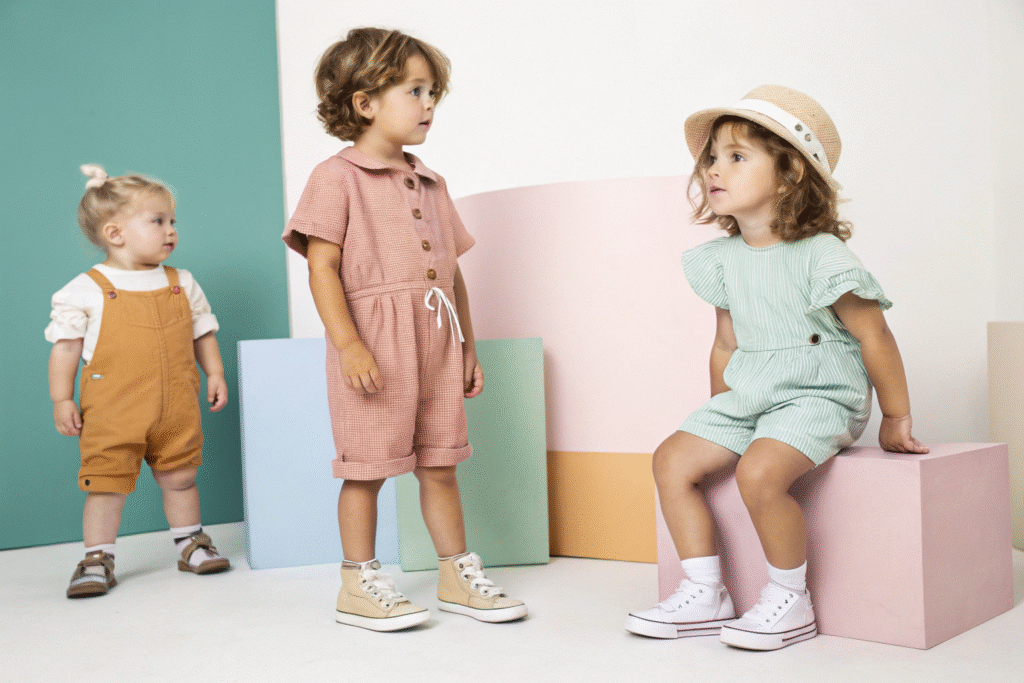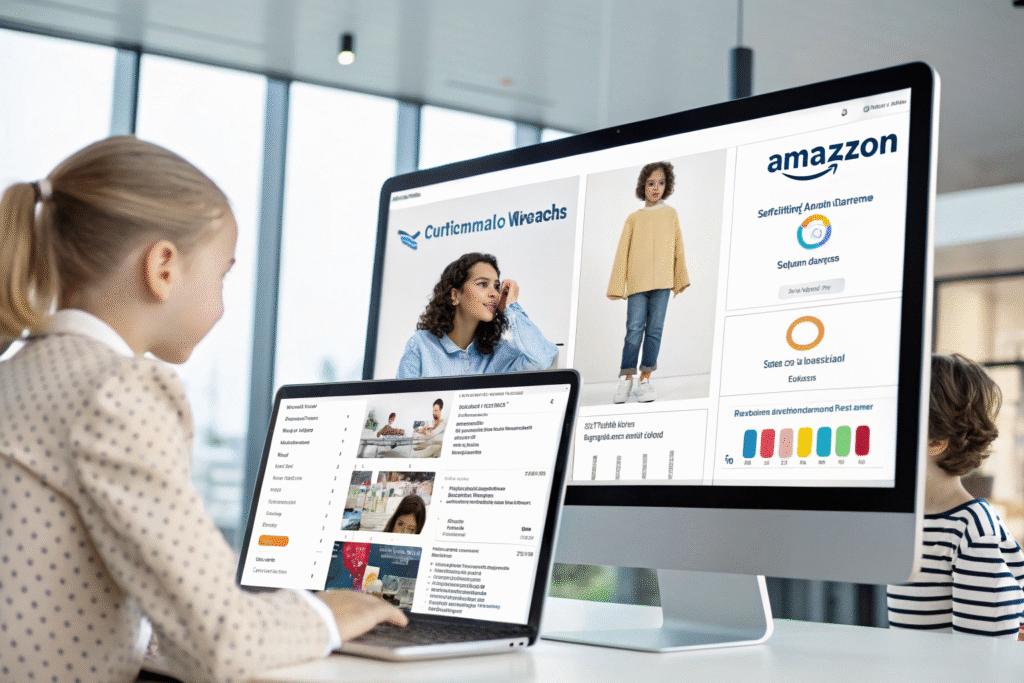Over the past decade, the online children’s ready-to-wear (RTW) market has experienced a transformation, driven by digital commerce, evolving parental preferences, and a global push toward stylish yet practical children’s apparel. As a Chinese manufacturer working closely with American and European brands, I’ve witnessed firsthand how much the digital shelf has overtaken traditional retail, especially post-pandemic.
The online children’s RTW market is currently valued at over $80 billion globally and is projected to surpass $120 billion by 2030. Digital-first parents, increasing dual-income households, and the rise of AI-powered recommendation engines are creating a perfect storm of growth opportunities for B2B players like us. These changes signal the importance of aligning our production cycles, trend forecasting, and packaging innovations with what’s actually selling online.
And if you’re a sourcing director, brand owner, or distributor like Ron—who wants both premium quality and efficient logistics—these trends matter. The real question is: how can you take advantage of this shift to grow your brand, cut delays, and stay relevant?
What Is the Current Size of the Global Children’s RTW Market?
The children’s RTW segment has expanded massively in digital retail channels. According to Statista, the global children’s apparel market hit $82.5 billion in 2024, with online sales contributing over 28% of total revenue. In the U.S. alone, eCommerce for kids’ wear now exceeds $12 billion annually.
This growth is largely driven by increased smartphone use, convenience-based purchasing behavior, and fashion-forward parents.

How Has COVID-19 Affected Online Children’s Wear Sales?
The pandemic served as a catalyst for many sectors, and children’s clothing was no exception. When brick-and-mortar stores shut down, parents turned to eCommerce. Retailers who adapted quickly reaped the rewards.
In fact, during 2020–2021, U.S. online sales of children’s clothing increased by over 40%, according to McKinsey’s retail report and Statista’s forecast. Now, many brands keep digital-first as a permanent sales model.
Which Countries Are Driving the Most Online Growth?
The U.S., U.K., and Germany are leading, but India and Southeast Asia are fast catching up, thanks to mobile commerce expansion. The APAC region is projected to grow at a CAGR of 10.4% through 2030 in the online children’s clothing segment.
Market intelligence platforms like Euromonitor International and Business of Fashion show significant shifts in buyer behavior and regional consumption. Buyers from emerging markets are now sourcing from China in larger volumes than ever.
What Trends Are Dominating Online Kidswear in 2025?
Today’s online children’s fashion is more than cartoon prints and frilly dresses. It’s miniature fashion-forward looks, sustainable materials, and gender-neutral basics. These trends aren’t just consumer-facing—they shape our production priorities, raw material sourcing, and even MOQ strategies.

Is Gender-Neutral Clothing Really Selling?
Yes—and the numbers don’t lie. According to Edited’s trend analytics, gender-neutral children’s wear grew by 38% in listings on global eCommerce platforms between 2022 and 2024. Major retailers like H&M Kids and Zara Mini now have dedicated unisex sections.
From a manufacturing side, this shift helps reduce overstock risks and supports a leaner SKU system. Clients like Ron appreciate fewer complications in rebranding gender-specific collections.
Are Sustainable Materials a Priority for Online Buyers?
More than ever. Organic cotton, bamboo rayon, and rPET blends are seeing rising demand among digitally-native parents. According to a GlobalData survey, 57% of online kidswear shoppers prioritize “eco-friendliness” over price.
We now work with certified mills for GOTS and OEKO-TEX® yarns. Partnering with us means your catalog checks all the boxes for sustainability keywords that boost visibility on eCommerce search algorithms.
What Platforms Are Most Profitable for Online RTW Sales?
For buyers like Ron, knowing where traffic and conversion happen online can guide which SKUs to scale. Amazon, Walmart, and Shopify-hosted DTC stores are leading channels in the U.S., while Zalando and ASOS dominate in Europe.

Is Amazon Still the King for Children’s Apparel?
Absolutely. With over 60,000+ active listings in baby and toddler categories, Amazon remains the biggest volume mover. Brands with FBA integration and Prime-eligible logistics can scale faster.
Our DDP service is optimized for Amazon sellers—just like Ron—looking for door-to-door, barcode-ready packaging with no customs surprises. Data from Marketplace Pulse shows that RTW sellers with verified logistics partners see 23% fewer order cancellations.
What About Emerging DTC Platforms?
Shopify and WooCommerce are becoming strong contenders. With lower fees and full branding control, many kidswear labels are moving off marketplaces. We assist several Shopify-first brands with pre-tagged, branded packaging and seasonal drops.
As seen on Shopify’s annual commerce report, brands that update collections quarterly and maintain size consistency grow up to 40% faster year-over-year.
How Can B2B Buyers Adapt to These Online Trends?
Adaptability is the key to remaining competitive. The best-performing online brands aren’t always the biggest—but they are the most responsive. Buyers like Ron, who embrace agile development, certified sourcing, and fast lead times, dominate online retail charts.

Can Small Batches Work for Online Testing?
Yes. With our low MOQ customization service, we’ve enabled several U.S. clients to test 50–100 pcs per SKU online. The winners go into reorders of 5,000+. This helps them avoid excess inventory and capitalize on real-time demand.
Clients using platforms like RangeMe and Faire benefit from data-led testing strategies that reduce launch failure rates.
What Logistics Strategies Reduce Online Selling Delays?
We recommend combining DDP shipping with forecast-based batching. For example, shipping three months’ worth of bestsellers to your U.S. 3PL via ocean, while keeping 10% in air shipment buffer stock, ensures continuity.
We use platforms like ShipBob and Flexport to integrate tracking with Shopify or Amazon accounts, reducing lost-time in customs or warehouse handoffs.
Conclusion
The children’s RTW market is evolving faster than ever. For buyers and brands, the digital playground offers not only visibility but a competitive edge—if you know how to respond. From choosing sustainable textiles, gender-neutral silhouettes, and agile logistics models, to selling smartly across platforms like Amazon and Shopify, success is now a product of data and partnerships.
We at Fumao Clothing are ready to help you make that shift. Let’s bring your vision to life, without delays or compromises.










